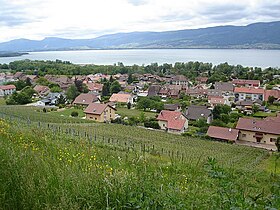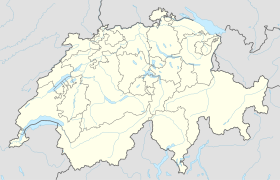Cheyres
| Cheyres | ||
|---|---|---|
| State : |
|
|
| Canton : |
|
|
| District : | Broye | |
| Municipality : | Cheyres-Châbles | |
| Postal code : | 1468 | |
| former BFS no. : | 2010 | |
| Coordinates : | 550285 / 184 987 | |
| Height : | 454 m above sea level M. | |
| Area : | 5.16 km² | |
| Residents: | 1434 (December 31, 2016) | |
| Population density : | 278 inhabitants per km² | |
| Website: | www.cheyres-chables.ch | |
|
Cheyres |
||
| map | ||
|
|
||
Cheyres ( Friborg Patois ) was a municipality in the Broye district of the canton of Friborg in Switzerland until December 31, 2016 . On January 1, 2017, Cheyres merged with the municipality of Châbles to form the new municipality of Cheyres-Châbles .
geography
Cheyres is 454 m above sea level. M. , six kilometers southwest of the district capital Estavayer-le-Lac (linear distance ). The former street row village extends on a terrace above the southern shore of Lake Neuchâtel , at the foot of the Molasse heights bordering to the south , in the northwestern Freiburg Central Plateau .
The area of the 5.2 km² municipal area comprises a section on the south bank of Lake Neuchâtel (around 3 km of the lakeshore line). In the area of Cheyres the lake has a shallow up to 500 m wide bank edge, which, with the exception of the area below the village, consists of a reed and swamp forest belt. These zones are part of the Grande Cariçaie nature reserve .
The community soil extends from the edge of the bank southwards over the terrace of Cheyres and over the steep slope to the plateau (on average 630 m above sea level ) of the Molasse hill country between Lake Neuchâtel and the Broyetal . The slope is divided by three short but deeply cut erosion valleys : from southwest to northeast these are the valley of the Ruisseau de la Croix (also known as Le Pissiau), the Combodon ditch and the Bonne Fontaine ditch . To the southwest, the area extends in a narrow corner up to the forest height of Les Râpes , at 698 m above sea level. M. is the highest point of Cheyres. This ridge is undercut by the A1 motorway in the 3 km long Arrissoules tunnel. In 1997, 11% of the municipal area was in settlements, 36% in forests and woodlands, 45% in agriculture and a little more than 8% was unproductive land (reed area).
Cheyres includes the hamlets of Le Moulin ( 440 m above sea level ) at the foot of the Molasse height northeast of the village, Champs d'Amont ( 636 m above sea level ) on the plateau east of the Combodon moat, as well as extensive holiday home areas near the lake and a few individual farms . Neighboring municipalities of Cheyres are Châbles and Murist in the canton of Friborg and Chavannes-le-Chêne , Rovray and Yvonand in the canton of Vaud .
population
With 1,434 inhabitants (as of December 31, 2016), Cheyres was one of the smaller communities in the canton of Friborg. 86.8% of the residents are French-speaking, 9.6% German-speaking and 1.5% speak Portuguese (as of 2000). The population of Cheyres was 381 in 1850 and 403 in 1900. In the course of the 20th century, the population always fluctuated in the range of 350 to 420 inhabitants. Only since 1980 (380 inhabitants) has a rapid population growth combined with a doubling of the number of inhabitants been recorded within 20 years.
economy
Cheyres was a predominantly agricultural village until the second half of the 20th century . Even today, have agriculture and livestock an important role in the employment structure of the population. In addition, there are some smaller wine-growing areas above the village and a significant number of fruit tree cultures , especially cherry trees. The Michel distillery was founded in 1894.
Other jobs are in local small businesses and the service sector, including construction and mechanical workshops. In the last few decades the village has also developed into a residential community thanks to its attractive location. Many workers are therefore commuters who work mainly in the regions of Estavayer-le-Lac and Yverdon-les-Bains .
tourism
Cheyres has been making efforts to boost tourism since the 1960s. Numerous holiday and weekend homes have been built in the flat zone near the lake shore, as well as a campsite, sports and leisure facilities and a port that opened in 2006.
traffic
The community is very well developed in terms of transport. It is located on the main road from Yverdon-les-Bains to Estavayer-le-Lac . On February 1, 1877, the railway line from Yverdon to Payerne with a station in Cheyres was put into operation. In addition, individual bus routes run by Transports publics Fribourgeois run from Estavayer-le-Lac to Cheyres.
history
Cheyres can look back on a very long tradition of settlement. On the shores of Lake Neuchâtel, the remains of settlements on the edge of the banks and pile dwellings from the Neolithic and Bronze Age have been discovered. There was also a camp here during Roman times .
The first written mention of the place took place in 1230 under the name Cheres ; from 1233 the name Chieres has been handed down. The place name is derived from the Latin villa Carias and probably goes back to the feminine Caria of the Roman personal name Carius .
In the Middle Ages , Cheyres was initially part of the Font-La Molière lordship, then after its division in 1441 it formed its own lordship, which also included Bollion and Seiry . Cheyres later experienced numerous changes of ownership: after Bern had conquered Vaud in 1536, it came under the rule of Friborg and was assigned to the Estavayer Bailiwick. The rule of Cheyres came to the Praroman family in Lausanne in 1560 and from them to Freiburg by purchase in 1704, where it was raised to its own bailiwick. Ecclesiastically, Cheyres belonged to the parish of Yvonand until the Reformation in 1536, since then it has formed an independent parish.
After the collapse of the Ancien Régime (1798), Cheyres was part of the Estavayer district during the Helvetic and subsequent periods and was incorporated into the Broye district in 1848.
Attractions
The core of the parish church of Saint-Nicolas dates back to the late 15th century, but was practically rebuilt between 1749 and 1752. She owned a 14th century Shrine Madonna, which was stolen in 1976 and replaced with a copy in 2000. The Notre-Dame de Bonne Fontaine chapel in the forest east of the village has long been an important place of pilgrimage.
The castle of Cheyres, which stands next to the church, also originally dates from the 15th century, but fell into ruins in the 18th century. It was rebuilt in 1772–74, was the residence of the bailiff appointed by Freiburg and has a richly carved front gable with the coat of arms of Freiburg. Some characteristic farmhouses from the 17th to 19th centuries have been preserved in the town center.




